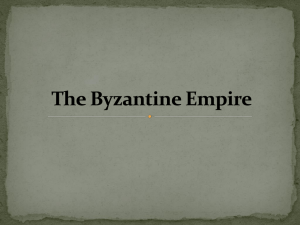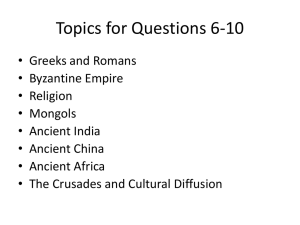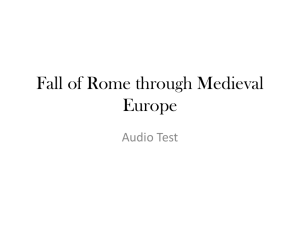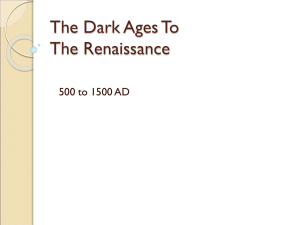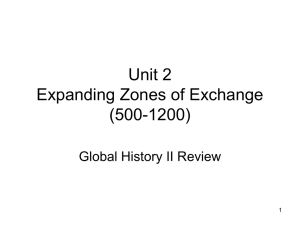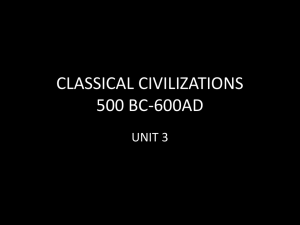Name: AP EUROPEAN HISTORY – SUMMER ASSIGNMENT TEST
advertisement
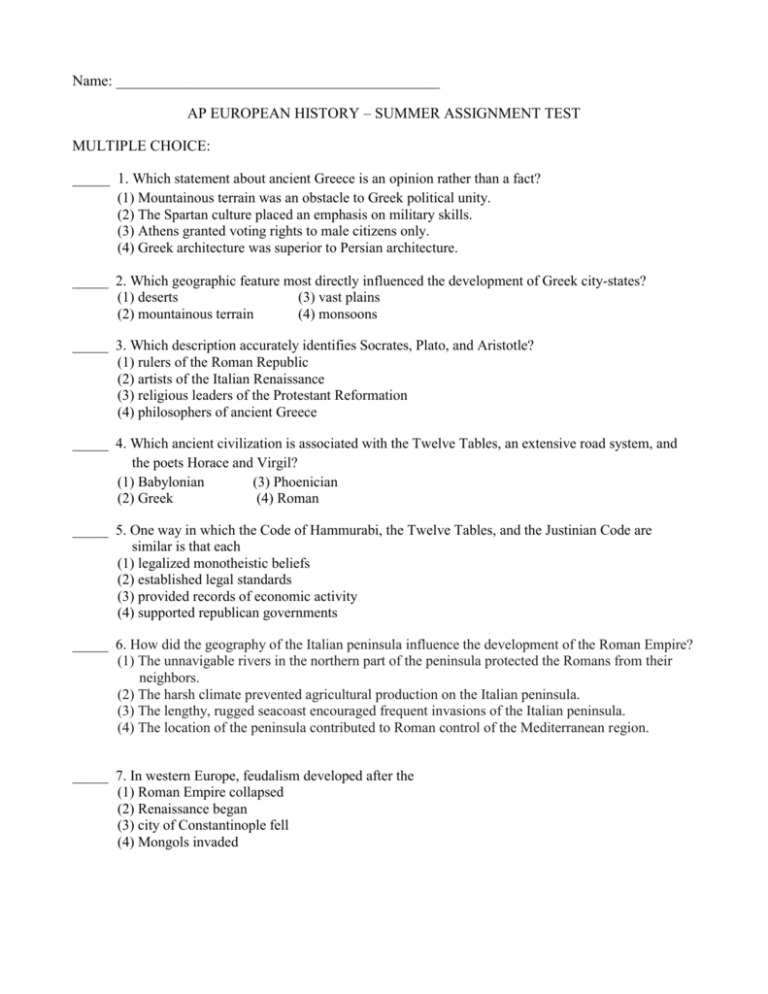
Name: ___________________________________________ AP EUROPEAN HISTORY – SUMMER ASSIGNMENT TEST MULTIPLE CHOICE: _____ 1. Which statement about ancient Greece is an opinion rather than a fact? (1) Mountainous terrain was an obstacle to Greek political unity. (2) The Spartan culture placed an emphasis on military skills. (3) Athens granted voting rights to male citizens only. (4) Greek architecture was superior to Persian architecture. _____ 2. Which geographic feature most directly influenced the development of Greek city-states? (1) deserts (3) vast plains (2) mountainous terrain (4) monsoons _____ 3. Which description accurately identifies Socrates, Plato, and Aristotle? (1) rulers of the Roman Republic (2) artists of the Italian Renaissance (3) religious leaders of the Protestant Reformation (4) philosophers of ancient Greece _____ 4. Which ancient civilization is associated with the Twelve Tables, an extensive road system, and the poets Horace and Virgil? (1) Babylonian (3) Phoenician (2) Greek (4) Roman _____ 5. One way in which the Code of Hammurabi, the Twelve Tables, and the Justinian Code are similar is that each (1) legalized monotheistic beliefs (2) established legal standards (3) provided records of economic activity (4) supported republican governments _____ 6. How did the geography of the Italian peninsula influence the development of the Roman Empire? (1) The unnavigable rivers in the northern part of the peninsula protected the Romans from their neighbors. (2) The harsh climate prevented agricultural production on the Italian peninsula. (3) The lengthy, rugged seacoast encouraged frequent invasions of the Italian peninsula. (4) The location of the peninsula contributed to Roman control of the Mediterranean region. _____ 7. In western Europe, feudalism developed after the (1) Roman Empire collapsed (2) Renaissance began (3) city of Constantinople fell (4) Mongols invaded Base your answer to question 8 on the map below and on your knowledge of social studies. _____ 8. Which conclusion about the Roman world around AD 526 can be drawn from the information on this map? (1) The Gauls dominated trade on the Mediterranean Sea. (2) Rome was the capital of the entire western region. (3) The eastern region was unified under the Byzantine Empire. (4) The division between eastern and western Rome followed natural boundaries. _____ 9. The term feudalism is best defined as a (1) holy war between Christians and Muslims (2) process in which goods are traded for other goods (3) division of political power between three separate branches (4) system in which land is exchanged for military service and loyalty _____10. An economic reason for the institution of serfdom was to maintain (1) an educated citizenry (2) a stable workforce (3) overseas trade (4) religious uniformity _____11. One long-term effect of the Crusades was the (1) development of Pax Mongolia (2) fall of the Ming dynasty (3) control of Jerusalem by Europeans (4) growth of trade and towns in western Europe Base your answers to questions 12 and 13 on the speakers’ statements below and on your knowledge of social studies. Speaker A: We must fight to keep control of Jerusalem in the hands of those who believe in Allah. Speaker B: Come and battle while there is still time to protect the Holy Land where Christ walked. Speaker C: We must go forth to heal the split between the churches. Speaker D: An investment in ships and knights will yield control of profitable trade routes. _____12. Which speaker expresses a Muslim perspective during the Crusades? (1) A (3) C (2) B (4) D _____13. Which speaker is expressing an economic motive for the Crusades? (1) A (3) C (2) B (4) D _____14. The bubonic plague affected economic development in medieval times by (1) encouraging the introduction of new types of crops (2) causing production to decline and prices to rise (3) sparking the ideas of socialism and reform (4) destroying the guild system _____15. During the European Middle Ages, guilds were created to (1) obtain better working conditions in factories (2) standardize goods and prices (3) regulate the money supply (4) increase competition _____16. • Stained glass windows assist people in understanding Biblical stories. • Taller and larger cathedrals emphasize the grandeur and glory of God. These statements best describe elements of (1) the Four Noble Truths (2) Chinese pagodas (3) Gothic architecture (4) Greek ideas _____17. Which institution served as the primary unifying force in medieval western Europe? (1) legislature (3) monarchy (2) church (4) military _____18. What is a primary characteristic of a feudal society? (1) a representative government (2) economic equality for all (3) protection of individual rights (4) an exchange of land for services _____19. What was the most important force in providing unity and stability throughout western Europe during the Middle Ages? (1) church (3) inquisition (2) nobility (4) military Base your answer to question 20 on the diagram below and on your knowledge of social studies. _____20. What does this illustration show about a typical manor? (1) All residents were treated equally. (2) Secular values in society were stressed. (3) There were a large number of factories. (4) People depended on agricultural production. Base your answer to question 21 on the graphic organizer below and on your knowledge of social studies. _____21. Which title best completes this graphic organizer? (1) Improvements Under the Tokugawa (2) Achievements of Medieval Europe (3) Developments in Ancient Ghana (4) Changes Resulting From the Counter Reformation _____22. What was one direct result of the Crusades? (1) Trade increased between Europe and the Middle East. (2) Islamic kingdoms expanded into Europe. (3) Arabs and Christians divided the city of Jerusalem between them. (4) Alexander the Great became a powerful leader in Eurasia. _____23. The Byzantine Empire influenced the development of Russia by (1) preventing Mongol invasions (2) destroying the power of the legislature (3) establishing the potato as a staple food (4) introducing Eastern Orthodox beliefs _____24. The Russian Orthodox Church developed as a result of Russia’s cultural interactions with which group? (1) Byzantines (3) Vikings (2) Muslims (4) Huns _____25. Which development is most closely associated with the beginning of the Byzantine Empire? (1) emergence of the Russian Orthodox Church (2) division of the Roman Empire (3) building of the Hagia Sophia (4) fall of Constantinople _____26. • Cyrillic alphabet adopted for use in Russia. • Russians accepted the teachings of the Orthodox Christian Church. • Onion-shaped domes dotted the skyline of Kievan Russia. Which term is most closely associated with these statements? (1) ethnocentrism (3) cultural diffusion (2) interdependence (4) colonialism Base your answers to questions 27 and 28 on the map below and on your knowledge of social studies. _____27. Which statement is best supported by the information on this map? (1) The Roman Empire extended over three continents. (2) Rivers kept invaders out of the Roman Empire. (3) Alexandria served as the eastern capital of the Roman Empire. (4) Carthage was eventually destroyed by the Romans. _____28. Based on the information provided by this map, which body of water was most likely the center of Roman trade? (1) Red Sea (3) Atlantic Ocean (2) Black Sea (4) Mediterranean Sea _____29. The early Russian civilization adopted the Eastern Orthodox religion, the Cyrillic alphabet, and different styles of art and architecture through contact with (1) traders from China (2) conquering Mongol invaders (3) Vikings from northern Europe (4) missionaries from the Byzantine Empire _____30. A major contribution of the Byzantine Empire was the (1) invention of the wheel and gunpowder (2) participation of citizens in government (3) diffusion of Hindu beliefs (4) preservation of Greek science and Roman engineering Base your answer to question 31 on the graphic organizer below and on your knowledge of social studies. ____31. Based on the information provided by this map, which statement about Constantinople is accurate? (1) Africans traded more goods in Constantinople than in any other area. (2) Constantinople was a city located on the Mediterranean Sea. (3) Gold was the primary commodity that China sent to Constantinople. (4) Constantinople was an important trading center. _____32. Which society practiced direct democracy? (1) ancient Athens (3) Gupta Empire (2) dynastic China (4) early Egypt _____33. What effect did the geography of ancient Greece have on its early development? (1) The mountainous terrain led to the creation of independent city-states. (2) A lack of natural seaports limited communication. (3) An inland location hindered trade and colonization. (4) Abundant natural resources encouraged self-sufficiency. _____34. Which circumstance best describes a long-term result of the Crusades? (1) Muslim control of Jerusalem ended. (2) Feudalism began in western Europe. (3) Cultural exchanges between the Middle East and Europe grew. (4) Christians and Muslims achieved a lasting peace. _____35. During the feudal period in Europe, power and position in society were based on the (1) amount of money earned (2) level of education achieved (3) number of slaves owned (4) amount of land possessed Base your answers to questions 36 and 37 on the illustration below and on your knowledge of social studies. _____36. Which concept is most closely related to the main idea of the illustration? (1) isolation (3) armed conflict (2) cultural diffusion (4) urbanization _____37. Which leader is most closely associated with the accomplishment shown by the illustration? (1) Charlemagne (3) Alexander the Great (2) Mansa Musa (4) Suleiman the Magnificent _____38. Constantinople’s location on the Bosporus Strait was one reason that the Byzantine Empire was able to (1) conquer the Russian city of Moscow (2) spread Judaism throughout western Europe (3) control key trade routes between Europe and Asia (4) unite the Eastern Orthodox and Roman Catholic Churches _____39. Some historians suggest that as a result of the Mongol invasions of Russia, the Russian people were (1) united with the Ottomans (2) converted to Christianity (3) freed from serfdom (4) cut off from most of western Europe _____40. “In 1469, Isabella of Castile married Ferdinand of Aragon. This marriage between the rulers of two powerful kingdoms opened the way for a unified state. Using their combined forces, the two monarchs made a final push against the Muslim stronghold of Granada. In 1492, Granada fell. . . .” Source: Elisabeth Ellis and Anthony Esler, World History: Connections to Today, Prentice Hall What is being described in this passage? (1) a crusade to the Holy Land (2) the reasons for the voyages of Columbus (3) the Spanish Reconquista (4) the start of the Italian Renaissance


